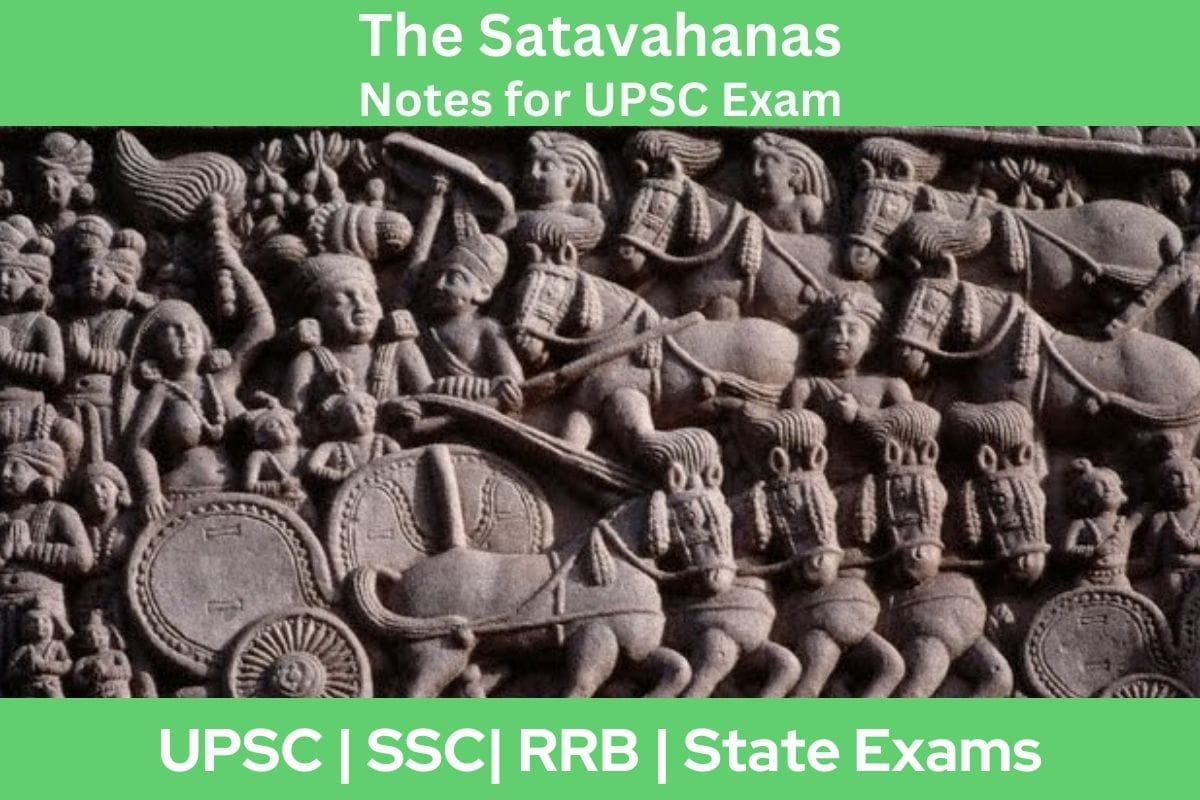
Satavahana Dynasty
The Satavahana dynasty began in the middle of the 1st century and lasted until the 3rd century. Although the dynasty’s origins are unclear, according to the Puranas, its first ruler defeated the Kanva dynasty. After the Maurya dynasty, the Satavahanas brought peace to the Deccan region and defended against foreign invasions, especially from the Western Saka Satraps. Some historians suggest that the Satavahanas initially established their rule in the modern Paithan area, expanding from there to the eastern Deccan, western coast, and Andhra.
The Rise Of Satavahana Dynasty
- The Sunga empire came to an end around 73 BCE when Vasudeva Kanva killed their ruler, Devabhuti. After that, the Kanva empire took control of Magadha for about 45 years.
- Then, a new powerful dynasty, the Satavahanas, took over in the Deccan region.
- The name “Satavahana” comes from the Prakrit language, meaning “driven by seven,” associated with the god Sun chariot that is pulled by seven horses.
- The first ruler of this dynasty was Simuka, and their capital was Pratishthana in Amaravati.
Important Rulers
Here are some key rulers of the Satavahana dynasty:
Simuka
- Simuka was the founder of the Satavahana dynasty, taking the throne soon after Ashoka’s death.
- He contributed to his kingdom by constructing Buddhist and Jain temples.
Satakarni I:
The third king of the dynasty, Satakarni I, ruled from 70 to 60 BC.
- Known for expanding his kingdom through military conquests, he conquered Kalinga after Kharavela’s death.
- He pushed the Sungas back in Pataliputra, conquered Madhya Pradesh, and gained fame as the ‘Lord of Dakshinapatha.’
- His wife, Nayanika, wrote an inscription named Naneghat, describing him as Dakshinapathapati.
- Satakarni I brought Brahmanism back to the Deccan through rituals like Ashvamedha Yagya.
Hala:
- Hala, another ruler, compiled the Gatha Saptashati, a collection of love poems in Prakrit.
- Gautamiputra Satakarni:
- Considered one of the greatest Satavahana kings, Gautamiputra Satakarni played a vital role in restoring the dynasty’s fortunes.
- He claimed Brahmana lineage and defeated the Shakas, Pahlavas, and destroyed the Kshaharata heritage of Nahapana.
- His reign extended from the river Krishna in the south to Saurashtra, Malwa, Berar, and Konkan.
- Known as the ‘Yavanas destroyer,’ he restored Satavahana glory and donated land to Buddhism.
Vashishti Putra Pulumavi:
- The immediate successor of Gautamiputra, Vashishti Putra Pulumavi’s inscriptions and coins were found in Andhra Pradesh.
- He married Rudradaman I’s daughter, and his reign saw some recovery of territories against the Shaka-Kshatrapas.
Yajna Sri Satakarni:
- A king with a keen interest in nautical and trade, Yajna Sri Satakarni reclaimed Malwa and Konkan against the Shakas.
- His coins, featuring ship designs, can be found in Andhra, Madhya Pradesh, Maharashtra, and Gujarat.
- The administration of the Satavahana Dynasty was guided by the Shastras, forming a distinctive structure:
Administration
- Ruler or King (Rajan): The leader of the dynasty was known as the Rajan.
- Princes or Rajas: Those individuals whose names appeared on coins were considered princes or Rajas.
- Maharathis: Maharathis had the authority to grant villages as rewards and were allowed to form marital relations with the ruling family.
- Mahatalavara: A significant administrative role in the dynasty.
- Maha Senapati: Held a crucial position as the Grand Commander in the administration.
Economy
The Satavahanas took part in and benefited from economic growth by expanding agriculture, increasing production of goods, and engaging in trade within and beyond India.
Settlements flourished in fertile areas, especially along major rivers, and agricultural land expanded through clearing forests and constructing irrigation reservoirs.
They controlled the Indian sea coast, dominating trade with the Roman Empire, with trade centers like Pratishthana and Tagara mentioned in historical accounts.
Culture and Religion
- The Satavahanas significantly influenced Indian culture. They were the first kings to grant land to practitioners of Buddhism and Brahmanism.
- Initially considered of lower caste, they later solidified their Brahminical credentials.
- Notable ruler Hala composed the treatise Saptasati, showing cultural contributions.
- They played a role in reviving Vedic Brahmanism in the Deccan, as seen in inscriptions and Puranic evidence.
- The practice of metronymics, naming emperors from the female lineage, was introduced, reflecting unique societal aspects.
Language
Most Satavahana inscriptions and coin legends are in a Middle Indo-Aryan language, often termed “Prakrit.” Sanskrit was also used in political inscriptions, though sparingly. Bilingual coins featuring both Middle Indo-Aryan and Tamil languages were issued.
Coinage
- The Satavahanas were early Indian rulers to issue coins with portraits. King Gautamiputra Satakarni initiated this practice.
- Thousands of lead, copper, and some gold and silver coins have been found in the Deccan region.
Architecture
Satavahana architecture is exemplified by the sculptures of the Amaravati Stupa, Buddhist stupas in various locations, and caves like Ajanta. They contributed to enlarging Ashokan stupas and constructing significant monuments.
Paintings
Satavahana paintings, found in Ajanta Caves, are the earliest surviving specimens in India. The paintings, especially in Caves No. 9 and 10, showcase religious themes.
Legacy
The Satavahanas left a lasting legacy, reviving Vedic Brahmanism and influencing rituals like the Ashvamedha yajna. Their contributions in faith, military power, and trade make them a crucial empire in Deccan and Indian history.







